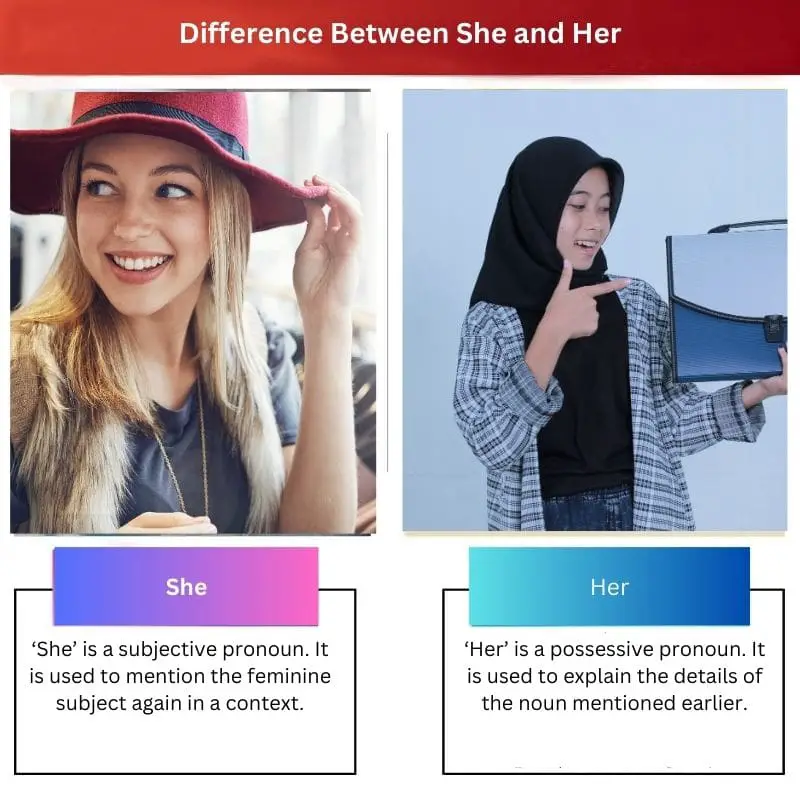Both ‘she ‘and ‘her’ are feminine pronouns. ‘She’ is a pronoun that is used to refer to a noun that mentions a female subject.
Key Takeaways
- “She” is a subjective pronoun used to refer to a female subject acting or in the state of being.
- “Her” is an objective pronoun and possessive adjective, referring to a female object receiving an action or indicating possession.
- Correct usage depends on the function of the word in a sentence, with “she” as the subject and “her” as the object or possessive form.
She vs. Her
The difference between She and Her is that ‘She’ is the pronoun that takes the place of the feminine noun mentioned earlier in a sentence. The pronoun ‘her’ is used in areas where the pronoun ‘she’ is mentioned earlier.

‘She’ is the pronoun that is substituted for a female noun. This noun may be mentioned earlier in the context.
‘Her’ is the pronoun that does a similar job as ‘She.’ ‘Her’ is used in places where the subject is already mentioned.
Comparison Table
| Parameter of Comparison | She | Her |
|---|---|---|
| Pronoun classification | ‘She’ is a subjective pronoun. It is used to mention the feminine subject again in a context. | ‘Her’ is a possessive pronoun. It is used to explain the details of the noun mentioned earlier. |
| Case | ‘She’ is used as a nominative pronoun. It is used to nominate a name in a context. | ‘Her’ is used as an accusative pronoun. It relates the noun with the verb referred to in the context. |
| Presence | ‘She’ comes in the place of the subject in a sentence. | ‘Her’ comes in the place of an object in a sentence. |
| Forms | ‘She’ refers to a pronoun alone. | ‘Her’ refers to an adjective as well as a pronoun. |
| Position | ‘She’ comes as a subject. So the sentence can start with it. | ‘Her’ comes as an adjective as well as a pronoun. So it is positioned after a preposition or a linking word. |
When to Use She?
‘She’ is an English pronoun used in literature to compensate for the repetition of a noun. Each time a feminine noun is used, to explain it, we use the pronoun ‘she.
‘She’ is used as a subjective pronoun. This means that it takes the place of the subject in a sentence.
At times, ‘She’ can also mention nonliving objects. There are particular objects for which the gender is fixed as female.
For example: ‘Neena hails from India. She is a graduate.’
- ‘Titanic was large. She was a beauty.’

When to Use Her?
‘Her’ is the proverb substituted for mentioning the secondary details about the noun. After saying the name of a feminine subject, we use ‘she’ in places where the noun is re-mentioned.
‘Her’ can be used as an objective pronoun. Since this pronoun comes as a secondary part, we can sometimes call this an object.
Similar to ‘she’ ‘her’ can also be used to explain something related to the female gender. It can also connect something that belongs to a nonliving thing commonly related to the feminine.
For example, She is bright. Her attitude is good.
- My pup is missing. Her kennel is empty.

Main Differences Between She and Her
- ‘She’ is used as a subjective pronoun, whereas ‘her’ is used as a possessive pronoun to add more possessiveness to a sentence.
- With the pronoun ‘she,’ we mention something about the subject and nominate it. We accuse the verb with the pronoun ‘her’ and relate it to the issue.
- ‘She’ takes only the pronoun form, but ‘her’ can be a pronoun and an adjective.
- ‘She’ takes the place of the subject of a sentence, while ‘he’ takes the place of the object in a sentence.
- ‘She’ is used at the beginning of a sentence, while ‘her’ can be used at any position according to the context.




